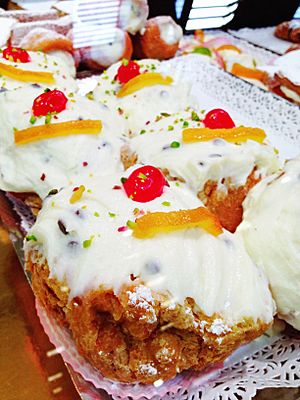Sfincia di San Giuseppe facts for kids
The Sfincia di San Giuseppe is a yummy dessert from Sicily, an island in Italy. People traditionally make and eat it on March 19th, which is St. Joseph's Day. It's so special that the Italian government officially recognizes it as a "Traditional Italian Regional Food Product."
This sweet treat is a soft, fried pastry. It's usually covered and filled with creamy, sweet ricotta cheese and colorful candied fruit, like cherry and orange pieces.
What's in a Name?
The name Sfincia or Spincia comes from old words that mean "sponge". This makes sense because the pastry is soft and spongy, just like a sponge!
The word might come from the Latin word spongia or the Arabic word isfanǧ. Both languages have influenced the Sicilian language over many years. In Italian, one is "Sfincia" and many are "Sfincie". In Sicilian, one is "Sfincia" (or "Spincia") and many are "Sfinci".
A Sweet History
Sfinci were first made in their modern form by nuns in Palermo, the capital city of Sicily. They adapted an old recipe from Persian and Arabic cooking.
The nuns dedicated these simple desserts to Saint Joseph. Later, bakers in the city made them even more special by adding creamy ricotta and sweet candied fruit.
In 1784, there was a small argument in Palermo about Sfinci! Tavern owners and pâtisserie (fancy bakery) owners both wanted to be the only ones allowed to make these desserts. The bakeries tried to get a special right called a "monopoly" (meaning they would be the only ones allowed to sell them), but they didn't succeed.
Today, you can easily find Sfinci in bakeries and pastry shops, especially in western Sicily.
See also
 In Spanish: Sfincia di San Giuseppe para niños
In Spanish: Sfincia di San Giuseppe para niños


